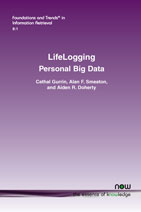LifeLogging: Personal Big Data
By Cathal Gurrin, Dublin City University, Ireland, cgurrin@computing.dcu.ie | Alan F. Smeaton, Dublin City University, Ireland, alan.smeaton@dcu.ie | Aiden R. Doherty, University of Oxford, UK, aiden.doherty@dph.ox.ac.uk
Abstract
We have recently observed a convergence of technologies to foster the emergence of lifelogging as a mainstream activity. Computer storage has become significantly cheaper, and advancements in sensing technology allows for the efficient sensing of personal activities, locations and the environment. This is best seen in the growing popularity of the quantified self movement, in which life activities are tracked using wearable sensors in the hope of better understanding human performance in a variety of tasks. This review aims to provide a comprehensive summary of lifelogging, to cover its research history, current technologies, and applications. Thus far, most of the lifelogging research has focused predominantly on visual lifelogging, hence we maintain this focus in this review. However, we also reflect on the challenges lifelogging poses for information access and retrieval in general. This review is a suitable reference for those seeking an information retrieval scientist’s perspective on lifelogging and the quantified self.
Lifelogging
Lifelogging represents a phenomenon whereby people can digitally record their own daily lives in varying amounts of detail, for a variety of purposes. In a sense it represents a comprehensive “black box” of a human’s life activities and may offer the potential to mine or infer knowledge about how we live our lives. We have recently observed a convergence of technologies to foster the emergence of lifelogging as a mainstream activity. Computer storage has become significantly cheaper, and advancements in sensing technology allows for the efficient sensing of personal activities, locations and the environment. This is best seen in the growing popularity of the quantified self movement, in which life activities are tracked using wearable sensors in the hope of better understanding human performance in a variety of tasks.
LifeLogging: Personal Big Data provides a comprehensive summary of lifelogging, to cover its research history, current technologies, and applications. Thus far, most of the lifelogging research has focused predominantly on visual lifelogging; hence the book maintains this focus. However, it also reflects on the challenges lifelogging poses for information access and retrieval in general.
LifeLogging: Personal Big Data is a suitable reference for those seeking an information retrieval scientist’s perspective on lifelogging and the quantified self.
